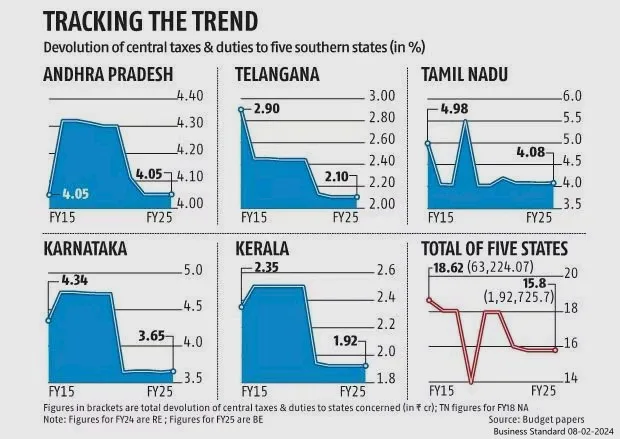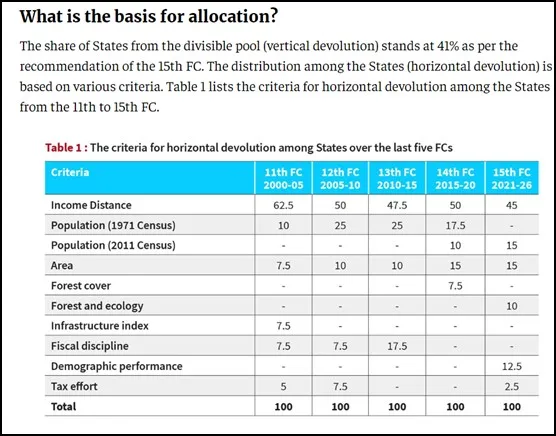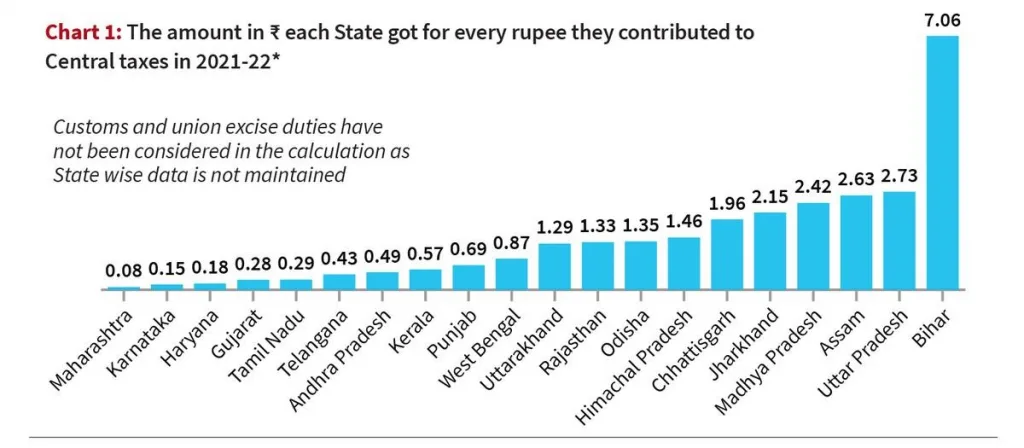States’Share in Divisible Pool of Taxes
Syllabus: GS 2/Governance
In News
- Tamil Nadu Chief Minister M.K. Stalin called for increasing States’ share in the divisible pool of taxes to 50% to address financial burdens and ensure financial autonomy.
Highlighted Issues
- The current share of 33.16% falls short of the XV Finance Commission’s recommended 41%, blaming the Union government’s increased surcharges and cesses.
- The financial burden on States is exacerbated by their increasing share in Union-State joint projects and reduced devolution rates.
- Tamil Nadu’s share in the devolution pool has declined from 7.93% (IX Finance Commission) to 4.07% (XV Finance Commission), which is described as punitive for well-performing States.

What is a divisible pool of taxes?
- Divisible pool is the portion of gross tax revenue which is distributed between the Union and the states.
- Article 270 of the Constitution provides for the scheme of distribution of net tax proceeds collected by the Union government between the Centre and the States.
- The taxes that are shared between the Union and the States include corporation tax, personal income tax, Central GST, the Centre’s share of the Integrated Goods and Services Tax (IGST) etc.
- This division is based on the recommendation of the Finance Commission (FC) that is constituted every five years as per the terms of Article 280.
- Apart from the share of taxes, States are also provided grants-in-aid as per the recommendation of the FC.
- The divisible pool, however, does not include cess and surcharge that are levied by the Centre.
- The 16th Finance Commission of India, chaired by Dr. Arvind Panagariya, has been constituted to make recommendations for the fiscal period 2026-31.
Allocation Mechanism
- Vertical Devolution: The 15th FC recommended 41% of the divisible pool for States.
- Horizontal Devolution: Based on criteria such as income distance, population (2011 Census), forest cover, demographic performance, and tax effort.

Key Issues
- Cess and Surcharge: Constitute 23% of the Union’s gross tax receipts but are excluded from the divisible pool, limiting States’ share to 32% of total tax revenue, below the 41% recommended.
- Revenue Disparity: Industrial States receive less than a rupee for every rupee contributed to Central taxes, while less developed States like Uttar Pradesh and Bihar receive more.

- Southern States’ Decline: Southern States’ share in the divisible pool has been reducing over six FCs due to higher weightage for equity-based criteria (income gap, population, and area) over efficiency-based criteria (demographic performance and tax effort).
- Grants-in-Aid Variations: Grants provided for revenue deficit, sector-specific needs, and local bodies differ widely among States.
Proposed Reforms
- Include Cess and Surcharge: Expand the divisible pool by including a portion of cess and surcharge, and reduce their imposition over time.
- Increase Efficiency Weightage: Add relative GST contributions as a criterion and give more weight to efficiency in horizontal devolution.
- Enhance State Participation: Establish a formal mechanism for State involvement in the Finance Commission, similar to the GST Council.
- Strengthen Fiscal Federalism: Encourage States to allocate adequate resources to local bodies to promote equitable development.
Conclusion and Way Forward
- The underdeveloped States need support, over-allocating funds to them at the expense of developed States could harm overall national development.
- Balancing equity and federalism requires reforms in revenue sharing, ensuring States contribute to and benefit from national development while preserving their financial autonomy.
Audit Diwas and Role of CAG
Syllabus: GS2/ Polity & Governance
Context
- On Audit Diwas (November 16th), the Lok Sabha Speaker said that the Comptroller & Auditor General (CAG) has played a key role in fostering accountability, transparency and good governance in the country.
About the Comptroller & Auditor General (CAG)
- Brief:
- It is a constitutional authority responsible for auditing the accounts of the Central and State governments.
- The Comptroller and Auditor General of India (CAG) is appointed by the President of India by a warrant under his hand and seal.
- Prior to taking over his/her office, the Comptroller and Auditor General of India (CAG) makes and subscribes to an oath or affirmation before the President of India.
- The CAG holds office for 6 years or up to the age of 65 years, whichever is earlier.
- CAG can be removed by the President of India on the same grounds and in the same manner as a judge of the Supreme Court.
- Constitutional Mandate:
- Article 148: Establishes the office of the CAG, appointed by the President for 6 years or until 65 years of age. Removal follows the process for Supreme Court judges, ensuring independence.
- Article 149: Defines the duties and powers of the CAG to audit Union, State, and public corporation accounts, as determined by Parliament.
- Article 150: Mandates that Union and State accounts are maintained in a format prescribed by the President on the advice of the CAG.
- Article 151: Requires the CAG’s audit reports to be presented to Parliament or State Legislatures through the President or Governor.
- Functions and Responsibilities:
- Audit of Government Accounts: The CAG audits the accounts of the Union and State governments and public sector organisations.
- It includes financial audits, compliance audits, and performance audits.
- Reporting to the Legislature: The CAG submits audit reports to the President or the Governor, who then places them before the Parliament or the State Legislature.
- These reports highlight any discrepancies or inefficiencies in the use of public funds.
- Advisory Role: The CAG advises the government on financial matters and helps in the formulation of policies to improve financial management and accountability.
CAG: Ensuring Transparency and Fixing Accountability
- Irregularities in Public Projects: The CAG’s reports have unveiled substantial cost escalations and financial mismanagement in major infrastructure projects.
- For instance, the construction cost of the Dwarka Expressway skyrocketed from ₹18 crore per kilometre to ₹250 crore per kilometre.
- Such findings have raised questions about the prudence and transparency of project management.
- Misallocation of Funds: The CAG has highlighted the diversion of funds from welfare schemes.
- In one instance, funds meant for the National Social Assistance Programme (NSAP) were redirected to promote other government schemes, impacting the intended beneficiaries. It has led to calls for stricter adherence to fund allocation guidelines.
- Healthcare Scheme Irregularities: The audit of the Ayushman Bharat—Pradhan Mantri Jan Arogya Yojana (PMJAY) revealed that ₹6.97 crore was disbursed for the treatment of patients who were recorded as deceased.
- Such discrepancies underscore the need for robust oversight mechanisms to prevent financial irregularities.
Key Concerns
- Increasing Complexity of Audits: As public administration and financial management become more complex, the CAG’s audits must adapt to new forms of corruption and maladministration that are increasingly difficult to detect.
- It includes auditing public-private partnerships (PPPs) and other innovative financial arrangements that require specialised knowledge and skills.
- Technological Advancements: While the adoption of emerging technologies like artificial intelligence and data analytics can enhance audit processes, it also presents a challenge.
- The CAG must continuously update its technological capabilities and ensure that its staff are adequately trained to use these tools effectively.
- It is essential for maintaining the credibility and accuracy of audits in a rapidly evolving digital environment.
- Maintaining Independence: The independence of the CAG is fundamental to its role in promoting accountability.
- However, there have been concerns about potential attempts to curtail the powers of the CAG, which could compromise its ability to conduct impartial audits.
- It is essential to safeguard the CAG’s autonomy to ensure that it can operate without undue influence from the executive or other entities.
- Capacity Building: Building and maintaining the capacity of the CAG’s workforce is another significant challenge.
- It includes not only technical training but also fostering a culture of integrity and professionalism. Continuous professional development and capacity-building initiatives are necessary to equip auditors with the skills needed to tackle emerging challenges effectively.
- Public Perception and Trust: Maintaining public trust in the CAG’s findings is crucial for its effectiveness. Any perception of bias or inefficiency can erode confidence in the institution.
- The CAG must ensure transparency in its operations and communicate its findings clearly to the public to uphold its reputation.
Way Ahead: Strengthening the CAG
- Adoption of Emerging Technologies: The CAG has proactively adopted emerging technologies, including artificial intelligence, to enhance its audit processes and ensure greater transparency.
- It is crucial for keeping pace with the dynamic landscape of public administration.
- International Collaboration: The CAG has strengthened its global presence by securing re-elections as the external auditor for several international organisations, such as the World Health Organization and the International Labour Organization.
- These roles underscore the CAG’s commitment to upholding high standards of professionalism and integrity in audit practices.
- The CAG has signed multiple Memorandums of Understanding (MoUs) with various countries to collaborate on public sector auditing. It includes recent agreements with Seychelles, Kenya, and Saudi Arabia.
- Institutional Support: There have been calls to provide the CAG with adequate institutional support to discharge its constitutionally enshrined role effectively.
- Strengthening the CAG involves ensuring its independence and empowering it to conduct comprehensive audits without undue interference
One Day One Genome Initiative
Syllabus: GS3/ Science and Technology
Context
- The Department of Biotechnology (DBT) and Biotechnology Research and Innovation Council (BRIC) introduced the ‘One Day One Genome’ initiative.
About
- The initiative aims to release the fully annotated genomes of unique bacterial species found in India, making the data publicly accessible.
- This will include detailed graphical summaries, genome assembly details, and infographics to inform about the microbes’ scientific and industrial applications.
Role of Microorganisms in Ecosystems
- Environmental Impact: It participates in biogeochemical cycles, soil formation, and degradation of pollutants.
- It contributes to methane production and global homeostasis.
- Agriculture: It facilitates nitrogen fixation, nutrient cycling, and pest control.
- Human Health: Symbiotic microorganisms outnumber human cells in the body and defend against pathogens.
- They also support digestion, immunity, and mental health.
Genome Sequencing
- It is the process of determining the complete DNA sequence of an organism’s genome, which includes all its genes and non-coding regions.
- It involves identifying the exact order of the four nucleotide bases (adenine, cytosine, guanine, and thymine) that make up the DNA.
Significance of Genome Sequencing
- Scientific Advancement: Enables identification of valuable microbial traits for sustainable innovations.
- Public Awareness: Encourages greater understanding of microbial diversity and its applications.
- Industrial Potential: Supports research in enzyme development, disease control, and bioactive compound discovery.
Way Ahead
- The One Day One Genome initiative will contribute to advancing microbial research in India, paving the way for scientific breakthroughs in biotechnology and sustainable development.
- By uncovering the hidden potential of microorganisms, the initiative aligns with global efforts to leverage biodiversity for societal benefit.
High-performance Buildings (HPBs)
Syllabus: GS3/Sustainable Development
Context
- High-performance buildings (HPBs) are at the forefront of sustainable construction.
About
- Globally, buildings account for nearly 40% of total final energy consumption over their lifespan, primarily for operational needs.
- According to the Bureau of Energy Efficiency in India, buildings account for more than 30% of the national energy use and 20% of its carbon emissions.
- This significant energy use leads to approximately 28% of energy-related carbon emissions.
What are High Performance Buildings?
- These buildings are engineered to achieve high standards in various areas, such as energy use, water conservation, air quality, and resource efficiency, while also considering long-term operational and economic sustainability.
- Energy Efficiency: HPBs are designed to reduce energy consumption significantly compared to conventional buildings.
- Sustainability: They incorporate sustainable materials, use water-saving technologies, and minimize environmental impact.
- Resilience and Adaptability: HPBs are designed to be adaptable to changing environmental conditions and resilient to climate challenges.
- This can involve flood-resistant designs, energy backup systems, and durable materials that withstand extreme weather.
Need
- Buildings are significant contributors to global emissions, especially in fast-growing cities, so improving their energy and carbon efficiency is vital.
- Failing to act could result in higher energy consumption, greater dependence on fossil fuels, and missed climate targets.
- With India’s urban population expected to reach 600 million by 2030, this challenge is becoming even more urgent.
Significance
- Cost Savings: Lower operational costs due to reduced energy and water consumption, as well as less maintenance.
- Urbanization Solution: HPBs offer proactive solutions for India’s rapid urbanization, driving the country toward a low-carbon, sustainable economy.
- Improved Health and Productivity: Occupants of HPBs typically experience better indoor air quality and comfort, leading to higher productivity and fewer health-related issues.
- Environmental Impact: HPBs reduce carbon emissions, lower waste generation, and use fewer resources, contributing to a more sustainable environment.
- Increased Market Value: These buildings often have higher resale value, increased tenant satisfaction, and are seen as desirable due to their environmental and health benefits.
Challenges
- High Cost: High-performance buildings often require a higher initial investment due to the cost of advanced materials, energy-efficient systems, and sustainable design features.
- Complexity of Integrating Systems: Designing and integrating various high-performance systems can be complex.
- Specialized Maintenance: HPBs often require specialized maintenance and operation practices due to the complexity of advanced systems.
- Regulatory and code barriers can slow down the adoption of high-performance building practices or lead to unforeseen complications during construction.
- Lack of Awareness: Ensuring that occupants understand and embrace sustainable building features requires ongoing education and engagement, which can be challenging to implement effectively.
Conclusion
- As cities grow, the demand for new construction also increases, and without action the sector’s carbon footprint will increase drastically.
- Adopting energy-efficient and low-carbon building practices is thus key to meet climate goals and to promote sustainable urban growth.
- HPBs — built to consume less energy, conserve resources, and withstand unpredictable weather — are an important part of achieving and keeping sustainable living.
Thai Sacbrood Virus
Syllabus: GS3/ Environment
Context
- The Thai Sacbrood Virus (TSBV) poses a significant threat to pollinators, vital for agricultural productivity and nutritional security.
Thai Sacbrood Virus
- It is a highly contagious viral disease that primarily affects Apis cerana indica (Asiatic honey bees).
- Symptoms: Infected larvae turn yellow and eventually black, adopting a sac-like appearance due to incomplete pupation.
- Geographical Spread: First identified in Southern India (1991-1992), it devastated nearly 90% of Asiatic honey bee (Apis cerana indica) colonies.
- It reemerged in Telangana in 2021 and also has been reported in China and Vietnam.
- Transmission: The exact transmission pathways remain unclear, likely mechanisms include:
- Direct contact: Spread through bee-to-bee interactions and contaminated hive equipment.
- Viral spillover occurs from managed honey bees to wild pollinators, which mutate the virus and increase its virulence.
Importance of Pollination
- Crop Yield: Pollination is essential for the reproduction of approximately 75% of global food crops.
- Ecosystem Services: Pollinators like bees, butterflies, and birds play a pivotal role in maintaining ecological balance and supporting other species in the food chain.
- Climate Resilience: Pollination aids in the adaptation of plants to changing climates by promoting genetic diversity.
Honey bees in India
- India hosts more than 700 bee species, including four indigenous honey bees:
- Asiatic honey bee (Apis cerana indica),
- Giant rock bee (Apis dorsata),
- Dwarf honey bee (Apis florea),
- The stingless bee (sp. Trigona).
- Western honey bees were introduced in India in 1983 to increase the country’s honey yield.
| Waggle dance and circle dance – Bees use two kinds of dances to communicate information: the waggle dance and the circle dance. – The purpose of either dance is for some honey bees to communicate to others the location of a flower patch with more nectar or pollen. 1. One bee dances while the others watch it to figure out the directions. Waggle dance – During a waggle dance, the bees move in a figure of eight formation. The dance indicates both the distance and the direction to the patch. – In this the straight line in the roughly figure of eight formation is called the waggle run. Circle dance – In a circle dance, the bees move in a circle. – The dance indicates only the distance to the hive. |